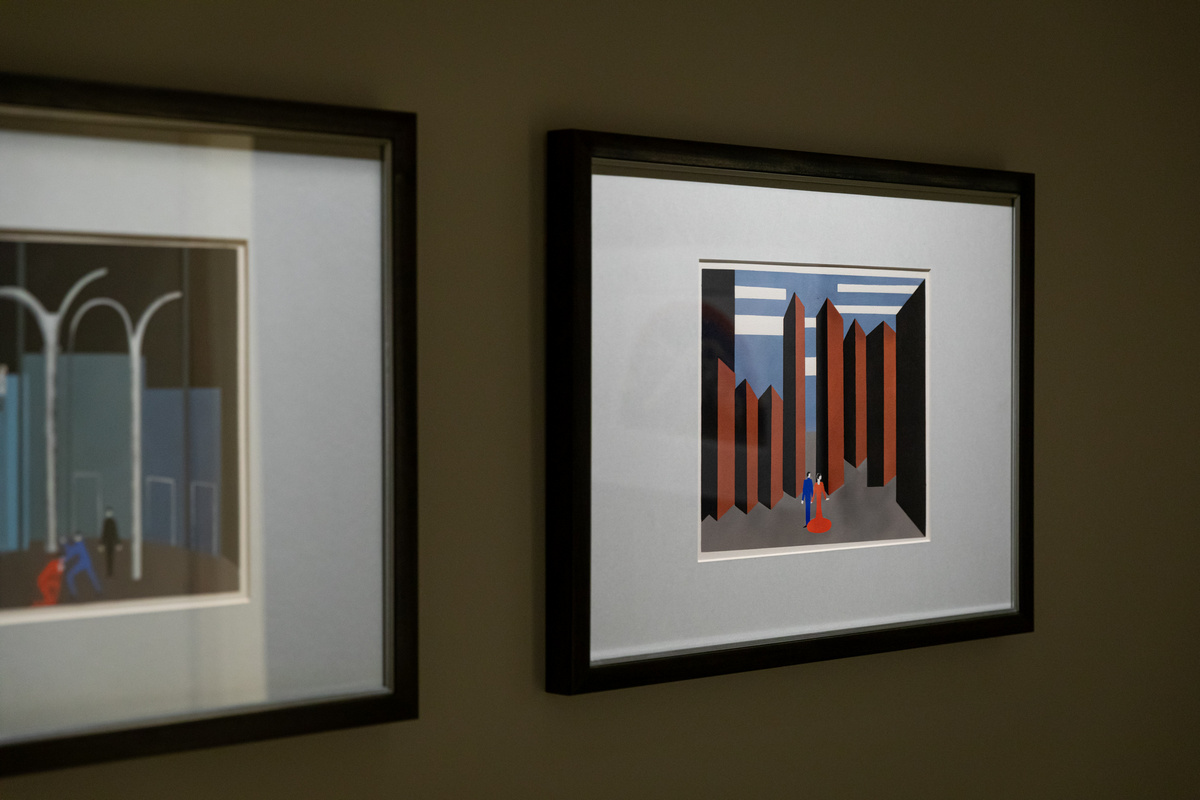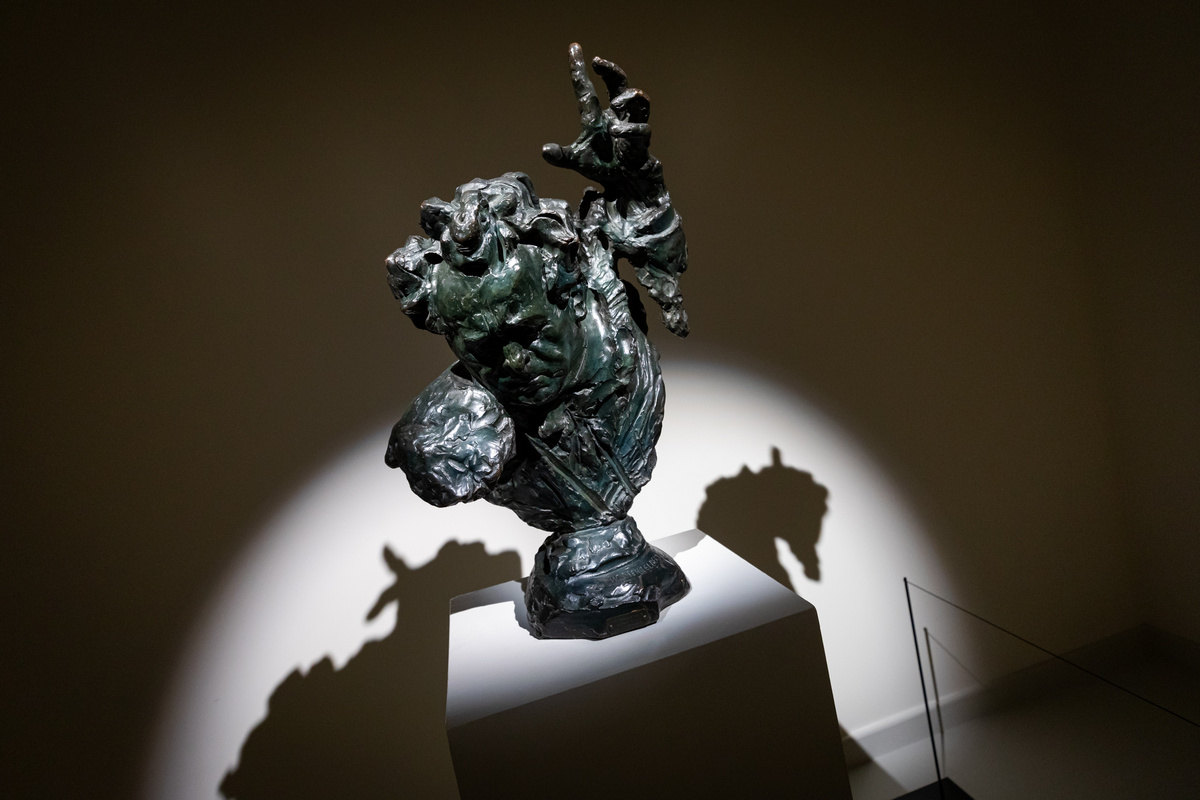The exhibition 'Creative Laboratory' presenting works by Olaksandr Bohomazov is followed by the exhibit of Oleksandra Ekster's and Oleksandr Archypenko's works
The exhibition Creative Laboratory presenting works by the distinguished artist of Ukrainian avant-garde, art theorist, and educator Olaksandr Bohomazov (1880–1930) at the Radvila Palace Museum of Art is followed by the exhibit showing stage set designs by Oleksandra Ekster (1882–1949) and a sculpture by Oleksandr Archypenko (1887–1964).

Oleksandra Ekster
Oleksandra Ekster was one of the leaders of Ukrainian avant-garde art, a prominent cubist and futurist, innovator of theatre and film, and one of the progenitors of the Art Deco style. Ekster was an original, multifaceted artist whose contribution was significant to the development of Ukrainian, Russian and European avant-garde painting, scenography and applied decorative arts. She was among the most prominent and most highly regarded artists in the modernist scene of the early 20th century.
Ekster was born into a family of a college assessor in the town of Bialystok (modern-day Poland) but the family later moved to Kyiv. She received her art education at the Mykola Murashka drawing school in Kyiv and, later on, at the Kyiv School of Arts. At the beginning of 1906, she travelled to Munich where she met the painter Aleksej von Jawlensky, as well as visiting Paris the following year. Ekster immediately joined a circle of world-famous artists such as Pablo Picasso, Georges Braque, Fernand Léger and the poet and art critic Guillaume Apollinaire. She studied at the Académie de la Grande Chaumière and became close with Italian futurists Filippo Marinetti and Ardengo Soffici. At that time, Ekster finally emerged as an artist of the ‘left’, gradually moving away from impressionism toward cubism and futurism. From 1908 onwards she participated in nearly every avant-garde exhibition in Kyiv, Odessa, Moscow, Saint Petersburg, Paris and Rome.
Ekster sought to radically overhaul the system of artistic expression. Her most characteristic traits were contrasting structural elements and an extraordinary intensity of colours, all tied together by the harmony of the picture plane. The artist brought the latest European trends into her motherland after filtering them through her own personal experiences. Ekster’s immediately recognisable style also incorporated the traditions of Ukrainian art, which later became the basis for her pedagogical concept. The artist first applied it while teaching at the Painting and Decorative Arts Workshop in Kyiv (1918). At Ekster’s studio, Ukrainian artists were encouraged to direct their experiments toward European modernism. Her studio was where the phenomenon we now call the Ukrainian avant-garde began to take shape. The work carried out in this studio laid the experimental foundations for the future Kyiv school of constructivist scenography.
While living in France, Ekster was invited by Léger to teach at the Paris Contemporary Art Academy (1925–1930), she designed ballet costumes for Vaslav Nijinsky’s plays, and worked in film studios in France and Germany. In the early 1930s, Ekster discovered a new area of creative expression in the form of making unique manuscript books. Several Lithuanian artists also studied under Ekster in Paris, including Antanas Gudaitis and Stasys Ušinskas, whom she taught scenography and certain principles of image building, which he later used in his work.
Studies into the expressiveness of colours and the correlation and relationships between them is a key characteristic of the artist’s work. It reflects the issues and contradictions of the era of great experiments that was the first quarter of the 20th century. Ekster’s work shows the value of experimentation and studying the properties of dynamics, space and colour. Her artistic evolution culminated in the constructivist style of the 1920s. The artist’s works from this time feature dynamic compositions and logical structures saturated with rhythmic lines and surfaces.
Ekster’s theatre work culminated in a collection of fifteen stage set designs for an album published by Galerie Aux Quatre Chemins in Paris in 1930. Tairov’s foreword was calligraphically handwritten by Ekster’s friend Guido Colucci, with whom she worked on André Gide’s book The Treatise of Narcissus (Le traite du Narcisse, 1933) and François Villon’s Testament (Le Lais, 1942).

Oleksandr Archypenko
Oleksandr Archypenko is one of the most prominent masters of sculpture of the 20th century. Through his innovative explorations, he created a three-dimensional embodiment for cubist, futurist and abstractionist ideas. He is deservedly called the first cubist sculptor, although Archipenko’s creative achievements actually reach much further.
The artist was born into the family of an engineer inventor; his father was a professor of mechanics and head of physics classes at Kyiv University, while his grandfather was interested in painting and made icons and biblical paintings.
In 1902–1905, the artist studied at the Kyiv art school together with the future leaders of the avant-garde movement, such as Oleksandra Ekster, Oleksandr Bohomazov, Aristarkh Lentulov, Aleksei Kruchenykh and Sergei Yastrebtsov (later known as Serge Ferat). In 1905, Archypenko was expelled from the school for participating in student strikes, and temporarily moved to Moscow, where he was introduced to the paintings of Paul Cézanne, Paul Gauguin and Henri Matisse, as well as sculptures by Antoine Bourdelle, which encouraged the young artist to continue his studies in European contemporary art hubs such as Berlin and Paris. In 1909, Archipenko settled in at the Paris art colony La Ruche. Having rejected education from art academies and studios, he studied and examined art monuments from various eras independently in Paris museums. The artist established his own art school in 1912.
Archypenko’s circles began to include various Paris school artists, including Albert Gleizes, Léopold Survage, Marcel Duchamp, Fernand Léger and Guillaume Apollinaire. Archipenko joined the cubist group Golden Section (Section d’Or) and began working on the concept of three-dimensional cubism, freely combining different materials (plaster, wood, glass, celluloid, wire etc.) and creating polychrome sculptures (Medrano, Pierre’s Carousel, Head). In 1914, he created the sculpture Boxers, which was one of the most famous pieces of abstract plastic art at the time. His works were on display at the Salon des Indépendants (yearly from 1910 to 1914, then in 1920) and the Salon d’Automne (1911–1913, 1919). In 1918, he was working, participating in exhibitions, and opened his own school in Germany.
While experimenting with volume and space, Archypenko created the first sculptural space that included voids as well as convex and concave shapes, which carried a certain psychological weight. The artist was exploring a new direction – so-called sculpto-painting – by adding colour to spatial sculptures (Spanish Woman, 1916; Still Life with Vase, 1918). In 1923, Archypenko moved to the USA. In Manhattan, the heart of New York, he led the Arko school of experimental ceramics, read lectures at universities and held numerous solo exhibitions.
At this time, he finally implemented an old idea he called ‘archipeinture’, which was based on a desire to render true motion within an artwork. His artistic engineering experiments resulted in the Archipeinture machine presented in 1928 during an exhibition in New York. The radical artistic idea broke out of traditional visual stereotypes. In archipeinture, motion becomes part of the creative process while the engineered device serves as an art object. The revolutionary nature of Archypenko’s ideas incorporated new foundational categories of ‘void’, ‘colour’ and ‘motion’ into the art of sculpture and predicted the proliferation of various art installations and performances.
The museum collection of Oleksandr Archipenko’s sculptures and graphic works is not particularly large, but prominent and unique in its own way. It presents artworks from various stylistic periods, including early cubism as well as later works that show the artist’s inclination toward various stylistic interpretations. One of the artist’s most prominent sculptures is his portrait bust Conductor Mengelberg.
In 1922–1928, Mengelberg was conducting the New York Philharmonic Orchestra. His performances were known for spectacular emotionality and unbridled temperament. Archypenko created the portrait bust Conductor Mengelberg after going to a concert in New York where the famous conductor performed Beethoven’s 9th symphony. The sculptor created a dynamic bronze etude that communicated a strongly pronounced expressive tension, evoking associations with the Baroque. There is a copy of the sculpture in Rotterdam.
Archypenko was so fascinated with Mangelberg’s genial performance and the scope and depth of the musical imagery the maestro created, that he decided to let go of his typical constructive, inventive methods, and instead give in to the emotional tension of his feelings. The conductor’s energetic performance was embodied in a highly dramatic image. Expressive sculpting of the face – anxiously tight lips, tense forehead, a manically twitching brow and an arm raised in a dynamic gesture – were what helped Archypenko not only create a great portrait but also embody Mengelberg’s famous performance technique. The artwork’s expressivity comes from the high technical ability with which it was made: rough fractures and bunching in the way clothing was sculpted emphasise the motion of the forms. Meanwhile, the forms themselves are built over upward diagonal lines arranged in a fast, upward spiral. Such compositional choices help bring out the maestro’s creative ability and his capability to feel the music of Beethoven’s 9th symphony.
The exhibition will be open until 25 July 2021.
Radvila Palace Museum of Art,
24 Vilniaus st, LT-01402, Vilnius, Lithuania
+370 5 250 5824













